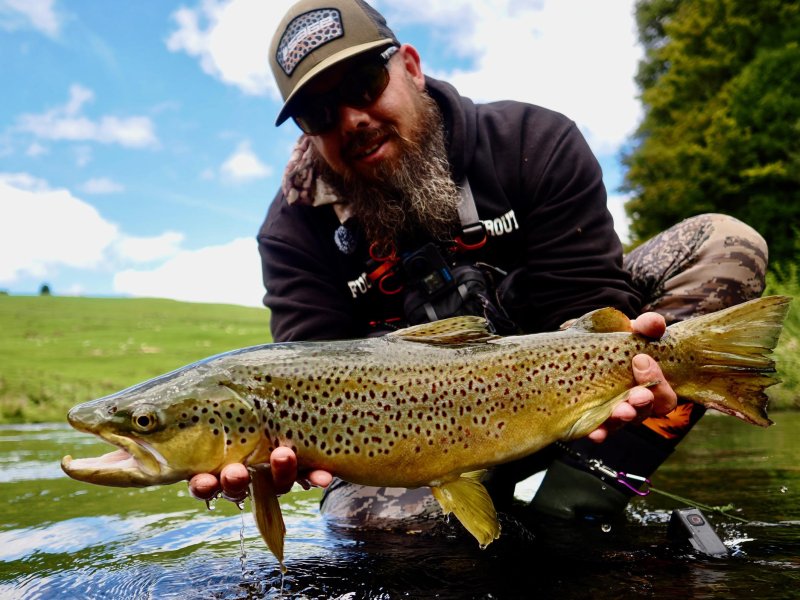Marakopa River
|
The Marokopa is a very scenic and easily accessed river divided into two systems by the spectacular Marokopa Falls. |
| Fish type | The Marokopa contains rainbow and brown trout in reasonable numbers averaging 1 to 2kg. |
| Situation | The Marokopa river rises near the world famous Waitomo Caves and then flows in a westerly direction to enter the Tasman Sea at the remote township of Marokopa. |
| Maps | |
| Check Conditions | View the MetService weather forecast. |
| Description | The Marokopa is a scenic river that is effectively divided into two systems by the spectacular Marokopa Falls (which are worth a visit in their own right). Most of the river is easy to access and easy to fish. It is made up of large boulder pools and long riffles. |
| Above the falls |
Description Above the Marokopa Falls, there is a 10-12km series of enticing runs and rapids punctuated by some deep pools. Methods Fly fishing is the best option above the falls. There is often an excellent evening rise in the months from November to late March. During the evening rise it is often best to have a dry fly on the dropper and a small submerged winged wet fly or emerger pattern below it. It is often the submerged fly that the fish spot and take. Access Take the road from Waitomo Caves to Te Anga and Marokopa which leaves SH3 8km south of Otorohanga. The river runs alongside the road for several kilometres allowing the angler easy access over farmland and through some bush. Where the road meanders away from the road, the angler should seek the landowner's permission before fishing. See the Marokopa River access map. |
| Below the falls |
Description Below the falls, the Marokopa River is joined by the Tawarau (a major fishing river in its own right and considerably larger). Directly below the falls the river runs through a gorge and has a series of rapids containing some interesting pocket water for the angler to explore. After the confluence with the Tawarau River, the Marokopa flows alongside the road and offers some large pools and small rapids. The enticing presence of schools of mullet have tempted many an angler who believes he is casting to reasonably sized trout. Unfortunately these largely sea water fish are not easy to catch by traditional fresh water fishing methods and are best ignored. A number of sea run trout are caught late in the season. In the final four kilometres the river becomes slow moving and tidal. Although large trout are resident, this section has little scenic beauty and is best left to the salt water angler and white-baiter. Those who wish to test their fishing gear can fish this section for the large kahawai and occasional kingfish that can be found in this section from mid spring through summer. Water quality The water, which is never crystal clear, becomes discoloured and takes several days to clear after a fresh rainfall. Trout are easier to spot and fly fishing is better when the river is low in summer (from late December). Methods This water is best suited to spin fishing. Nymph fishing using small nymphs is very effective throughout the season. In the summer, drifting a dry fly through some pools can also produce fish. Kahawai fishing at the mouth Over the past few years, there has beena growing interest in targeting the hard-fighting kahawai with light gear such as small spinners and flies. This is usually done at the mouth of the river where the kahawai come into the shallows chasing whitebait. Access Take the road from Waitomo Caves to Te Anga and Marokopa which leaves SH3 8km south of Otorohanga. Between Te Anga and Marokopa township the road runs alongside the Marokopa River, making access to the river easy. There is also public access from Speedies Road. See the Marakopa River access map. |
| Recommended lures |
Spinning Small bladed spinners such as the Mepps and Veltic are the most productive. Other spinners such as the Toby and Zed Spinner can also be effective, particularly below the falls and at the mouth for kahawai. Nymphs Popular nymphs include small Hare and Copper, Pheasants Tail and small midge patterns. Most flies are in the size 14 to 16 range. Dry fly Dry flies vary according to the hatch with Green Beetle and cicada patterns being very effective in the summer months during the day when these insects |
| Tributaries | Tributaries of the Marokopa include the: - Mangaohae Stream - Tawarau River - Managapohue Stream - Puaroa Stream |
| Regulations | |
| Region | Auckland/Waikato |
| Season | Below Mangatuahaua Stream: All year Above Mangatuahaua Stream: Oct 1- June 30 |
| Methods | Spinner, fly and bait downstream from Mangatuaaua Stream confluence
Upstream of Mangatuaaua Stream confluence spin and fly-fishing only |
| Bag limit | 5 |
| Size limit (cm) | 30cm minimum |



